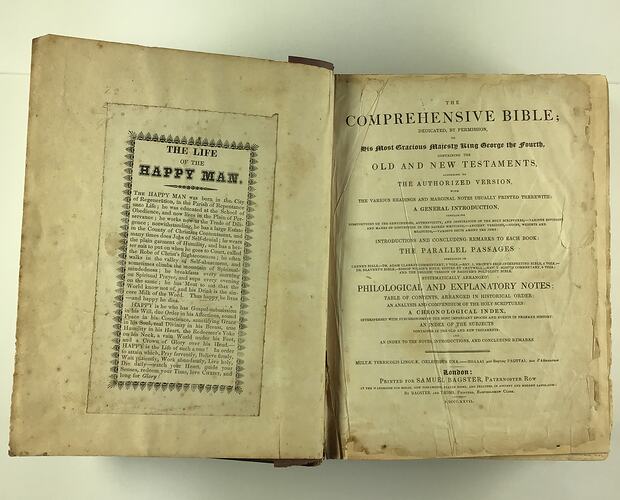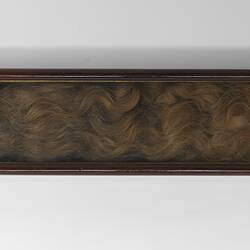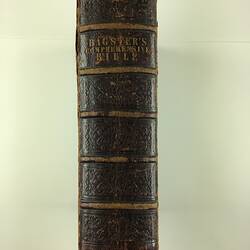Summary
A portrait painting, mourning box containing a lock of hair and a family Bible reveal a poignant story of migration, settlement and loss.
Family Background:
The Museum holds a significant collection of items relating to the lives of Francis Robertson Wallen, his wife Catherine (formerly Hobson), and their fourteen children, in particular their daughter Eliza Bushe Wallen. The family arrived from County Derry, Ireland in Melbourne in November 1852 on the maiden voyage of the SS Great Britain to Australia, and over the years lived in Collingwood, Richmond and Hawthorn. Francis established the firm F.R. Wallen & Sons in Queen Street Melbourne shortly after arriving, and his eldest son Robert Elias went on to be the first chair of the Melbourne Stock Exchange.
The collection includes the Wallen family Bible (HT 59764), a watercolour and gouache portrait of Eliza Wallen (HT 54014), and a mourning box containing a lock of Eliza's hair (HT 52124). Portrait and Mourning Box: Early in 1854 H. C. Schiller was commissioned by the family to produce a watercolour and gouache painting of Eliza. Eliza became ill with colonial (typhoid) fever, and on 7 March 1854, aged just 17 years, she succumbed to her illness. It is believed that the painting was completed after her death.
A lock of Eliza's hair secured by a bell-shaped gold clasp is inscribed with her name and the date of her death, and preserved in a small wooden glass-fronted case. The portrait held pride of place in the family dining room acting as a conscious daily reminder of Eliza's story for decades after her death. Eliza is buried with a number of family members in the Wallen family grave (C of E Grave No 404) in the Melbourne General Cemetery, near the Burke and Will's memorial.
The painting and mourning box were handed down through the family as precious heirlooms until they were donated to Museums Victoria in 2017 and 2018.
Family Bible:
The Bible was 'The Comprehensive Bible', English edition, published by Samuel Bagster, Paternoster, London, England, 1827. The Bible contains both the Old and the New Testaments, and endpapers record the births, baptisms, deaths and marriages in the Wallen family of Francis (1791-1886), Catherine (1812-1897), their fourteen children and some of their marriages.
The first entry is by Catherine recording that 'Mr Wallen and the children had the measles...' Eight of the Wallen children died young, and their deaths are recorded with sentimental verses. A poignant note in the Bible records the verses read to Eliza as she lay dying, as well as her last words. It also contains the last words of her elder brother Alexander George who died from typhoid in February, just a few weeks before Eliza.
A deeply religious Protestant family, there are many hand-written notations throughout the Bible's printed text. The annotations appear to reflect the family's questioning of literal interpretations of the Old Testament, such as whether the dimensions of Noah's Ark could accommodate the number of animals it purportedly carried; and calculations of Solomon's wealth as described in the Bible which converted gold ducats into pounds sterling. There are also quite lengthy critiques of sermons to which the family had listened.
As was the custom of the day, leaves and flowers were pressed between the pages. A particularly touching example is a pressed flower labelled 'Fairy Mount 1851', picked from the garden of the family's home in County Derry, Ireland, before leaving to emigrate to Australia.
This Bible, along with the mourning box and portrait painting of Eliza, were treasured by five generations of the Wallen family and their descendants who have acted as custodians for these family heirlooms and story. The items were originally owned by Francis Robertson and Catherine Wallen (nee Hobson), then held by their son Francis Hobson Wallen. He then passed them to Francis's son Robert Wallen and then on to his cousin Trevor Conor Knaggs and Trevor Conor's daughter Caroline Knaggs (great, great granddaughter of Francis and Catherine Wallen).
The Bible was donated to Museums Victoria reuniting the three precious objects in 2023.
Death and Mourning:
These objects all speak to the highly structured traditions of mourning during the Victorian era where grieving was in many cases a public not a private act. During the Victorian era hair was commonly used in items to remember the dead as it was seen as the most delicate yet lasting of materials which survived someone's passing like love. It allowed relatives and loved ones to almost look up to Heaven and speak to the deceased. (Taylor, Lou, 2009. 'Mourning Dress: A Costume and Social History', Routledge, London.)
Bibles were commonly used by generations of one family to record their family trees, dates of members' births, marriages and deaths, and so became precious family heirlooms passed down through the generations.
More Information
-
Keywords
-
Authors
-
Article types



